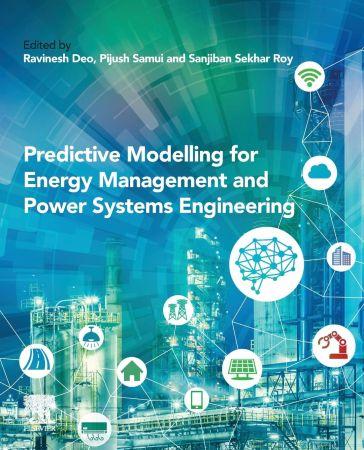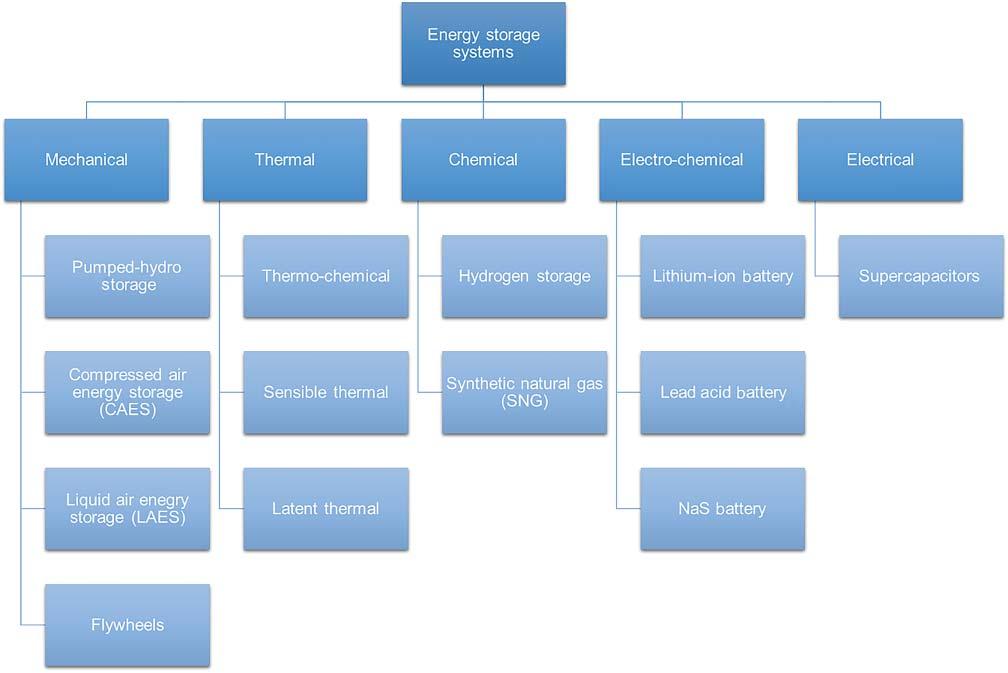Technologies for Integrated Energy Systems and Networks Giorgio Graditi
Visit to download the full and correct content document: https://ebookmass.com/product/technologies-for-integrated-energy-systems-and-netw orks-giorgio-graditi/
More products digital (pdf, epub, mobi) instant download maybe you interests ...
Distributed Energy Resources in Local Integrated Energy Systems: Optimal Operation and Planning Giorgio Graditi
https://ebookmass.com/product/distributed-energy-resources-inlocal-integrated-energy-systems-optimal-operation-and-planninggiorgio-graditi/
Energy Storage Systems: System Design and Storage Technologies Armin U. Schmiegel
https://ebookmass.com/product/energy-storage-systems-systemdesign-and-storage-technologies-armin-u-schmiegel/
Optimal Operation of Integrated Multi-Energy Systems Under Uncertainty 1st Edition Wu
https://ebookmass.com/product/optimal-operation-of-integratedmulti-energy-systems-under-uncertainty-1st-edition-wu/
Integrated Environmental Technologies for Wastewater Treatment and Sustainable Development Vineet Kumar
https://ebookmass.com/product/integrated-environmentaltechnologies-for-wastewater-treatment-and-sustainabledevelopment-vineet-kumar/
Machinery and Energy Systems for the Hydrogen Economy
Klaus Brun
https://ebookmass.com/product/machinery-and-energy-systems-forthe-hydrogen-economy-klaus-brun/
Integrated Sustainable Urban Water, Energy, and Solids Managementpresents an integrated and sustainable system of Vladimir Novotny
https://ebookmass.com/product/integrated-sustainable-urban-waterenergy-and-solids-managementpresents-an-integrated-andsustainable-system-of-vladimir-novotny/
Hybrid Energy Systems for Offshore Applications Ibrahim Dincer
https://ebookmass.com/product/hybrid-energy-systems-for-offshoreapplications-ibrahim-dincer/
Predictive Modelling for Energy Management and Power Systems Engineering Ravinesh Deo
https://ebookmass.com/product/predictive-modelling-for-energymanagement-and-power-systems-engineering-ravinesh-deo/
Energy Storage Devices for Renewable Energy-Based Systems: Rechargeable Batteries and Supercapacitors 2nd Edition Nihal Kularatna
https://ebookmass.com/product/energy-storage-devices-forrenewable-energy-based-systems-rechargeable-batteries-andsupercapacitors-2nd-edition-nihal-kularatna/
Editedby GiorgioGraditiandMarialauraDiSomma
TheEditors
Dr.GiorgioGraditi
ItalianNationalAgencyforNew Technologies
EnergyandSustainableEconomic Development
ENEA,DepartmentofEnergy TechnologiesandRenewableSources
Rome,Italy
Dr.MarialauraDiSomma
ItalianNationalAgencyforNew Technologies EnergyandSustainableEconomic Development
ENEA,DepartmentofEnergy TechnologiesandRenewableSources Rome,Italy
CoverImage: ©zfL/GettyImages
Allbookspublishedby WILEY-VCH arecarefully produced.Nevertheless,authors,editors,and publisherdonotwarranttheinformation containedinthesebooks,includingthisbook, tobefreeoferrors.Readersareadvisedtokeep inmindthatstatements,data,illustrations, proceduraldetailsorotheritemsmay inadvertentlybeinaccurate.
LibraryofCongressCardNo.: appliedfor
BritishLibraryCataloguing-in-PublicationData Acataloguerecordforthisbookisavailable fromtheBritishLibrary.
Bibliographicinformationpublishedby theDeutscheNationalbibliothek TheDeutscheNationalbibliothekliststhis publicationintheDeutscheNationalbibliografie;detailedbibliographicdataareavailable ontheInternetat <http://dnb.d-nb.de>.
©2022WILEY-VCHGmbH,Boschstr.12, 69469Weinheim,Germany
Allrightsreserved(includingthoseof translationintootherlanguages).Nopartof thisbookmaybereproducedinanyform–by photoprinting,microfilm,oranyothermeans–nortransmittedortranslatedintoamachine languagewithoutwrittenpermissionfromthe publishers.Registerednames,trademarks,etc. usedinthisbook,evenwhennotspecifically markedassuch,arenottobeconsidered unprotectedbylaw.
PrintISBN: 978-3-527-34899-2
ePDFISBN: 978-3-527-83361-0
ePubISBN: 978-3-527-83362-7
oBookISBN: 978-3-527-83363-4
Typesetting Straive,Chennai,India
Printedonacid-freepaper 10987654321
Contents
1ChallengesandOpportunitiesoftheEnergyTransitionand theAddedValueofEnergySystemsIntegration 1
MarialauraDiSommaandGiorgioGraditi
1.1EnergyTransformationTowardDecarbonizationandtheAddedValueof EnergySystemsIntegration 1
1.2EuropeanUnionastheGlobalLeaderinEnergyTransition 6
1.3PillarsfortheTransitionTowardIntegratedDecentralizedEnergy Systems 11
ListofAbbreviations 13 References 13
2IntegratedEnergySystems:TheEngineforEnergy Transition 15
MarialauraDiSommaandGiorgioGraditi
2.1Introduction:theConceptofIntegratedEnergySystem 15
2.2KeyEnablersforIntegratedEnergySystems 18
2.2.1StorageandConversionTechnologies 18
2.2.2EndUserEngagementandEmpowerment 22
2.2.3DigitalizationEnabler 24
2.2.4EmergenceofanIntegratedEnergyMarket 27
2.3IntegratedEnergySystemsattheLocalLevel 28
2.3.1ConceptualizingLocalIntegratedEnergySystems 28
2.3.2MapofEnablingTechnologies 29
2.3.3KeyStakeholdersandRelatedBenefitsfromLocalIntegratedEnergy SystemsDeployment 31
2.4MainBarriersforImplementation 33
2.4.1Techno-economicBarriers 34
2.4.2SocioeconomicBarriers 35
2.4.3PolicyandRegulatoryBarriers 35
2.5Conclusions 36
ListofAbbreviations 38 References 38
3PowerConversionTechnologies:TheAdventofPower-to-Gas, Power-to-Liquid,andPower-to-Heat 41
JoshuaA.Schaidle,R.GaryGrim,LingTao,MarkRuth,KevinHarrison, NancyDowe,ColinMcMillan,ShantiPless,andDouglasJ.Arent
3.1Introduction 41
3.1.1MotivationforPower-to-X 41
3.1.2DefiningPower-to-XCategories 43
3.1.3GoalofthisChapter 44
3.2Power-to-XTechnologies 44
3.2.1Power-to-Gas 44
3.2.1.1NaturalGasMarketDemand 45
3.2.1.2TechnologyIdentificationandOverview 46
3.2.1.3UniqueIntegrationChallengesandOpportunities 47
3.2.2Power-to-Chemicals-and-Fuels 48
3.2.2.1MarketandDemand 48
3.2.2.2TechnologyIdentificationandOverview 49
3.2.2.3UniqueIntegrationChallengesandOpportunities 54
3.2.2.4ImplicationsonPowerGeneration 54
3.2.3Power-to-Heat 57
3.2.3.1MarketandDemand 57
3.2.3.2TechnologyIdentificationandOverview 60
3.2.3.3UniqueIntegrationChallengesandOpportunities 60
3.2.3.4ImplicationsonPowerGeneration 62
3.3OverarchingChallenges,Opportunities,andConsiderations 62
3.3.1FeedstockandEnergySourcing 62
3.3.1.1Feedstocks(CO2 ,N2 ,H2 O,andBiomass) 62
3.3.1.2OperationalFlexibilityforGridIntegrationandRevenue 63
3.3.2KeyConsiderationsfromLifeCycleAnalysisandTechno-economic Analysis 64
3.3.2.1LifeCycleAnalysis 64
3.3.2.2Techno-EconomicAnalysis 64
3.3.3BusinessModelandBusinessInnovation 65
3.4ConcludingRemarks 66 Disclaimer 66
ListofAbbreviations 66 References 67
4RoleofHydrogeninLow-CarbonEnergyFuture 71
AndreaMonfortiFerrario,VivianaCigolotti,AnaMarìaRuz,FelipeGallardo, JoseGarcía,andGiuliaMonteleone
4.1Introduction 71
4.2MainDriversforHydrogenImplementation 72
4.2.1IncreasingPenetrationofStochasticRenewableEnergy 73
4.2.2OpportunityofHydrogenasaSectorCouplingEnabler 74
4.3HydrogenEconomyandPolicyinEuropeandWorldwide 74
4.4MainRenewableHydrogenProduction,Storage,and Transmission/DistributionSchemes 77
4.4.1HydrogenProductionPathways 77
4.4.2HydrogenTransmissionandDistribution 79
4.4.2.1MainHydrogenStorageTechnologies 79
4.4.2.2MethodsforHydrogenTransmissionandDistribution 81
4.5TechnologicalApplicationsinIntegratedEnergySystemsand Networks 83
4.5.1HydrogenasanEnergyStorageSystemforFlexibilityatDifferent Scales 83
4.5.2IndustrialUseasaRenewableFeedstockinHard-to-AbateSectorsand fortheProductionofDerivates 84
4.5.3HydrogenMobility:AComplementarySolutiontoBatteryElectric Vehicles 85
4.5.4FuelCells,FlexibleElectrochemicalConversionSystemsfor High-EfficiencyPower,and/orCHPApplications 86
4.6Conclusions 89
ListofAbbreviations 90 References 91
5ReviewontheEnergyStorageTechnologieswiththeFocuson Multi-EnergySystems 105 MortezaVahid-Ghavidel,SaraJavadi,MatthewGough,MohammadS.Javadi, SérgioF.Santos,MiadrezaShafie-khah,andJoãoP.S.Catalão
5.1Introduction 105
5.2EnergyStorage 106
5.2.1MainConceptofEnergyStorageinthePowerSystem 106
5.2.2DifferentTypesofEnergyStorageSystems 108
5.2.2.1ElectromechanicalEnergyStorageSystems 110
5.2.2.2ElectromagneticEnergyStorageSystems 111
5.2.2.3ElectrochemicalEnergyStorageSystems 112
5.2.2.4ThermalEnergyStorageSystems 113
5.2.3AdvantagesofStorageintheEnergySystem 113
5.3EnergyStorageTechnologyApplicationintheMulti-Energy Systems 116
5.4Conclusion 118
ListofAbbreviations 119 References 119
6DigitalizationandSmartEnergyDevices 123 MaherChebbo
6.1Introduction 123
6.2OurVisionoftheDigitalNetworks 130
6.3EnablingState-of-the-ArtDigitalTechnologies 138
6.4KeyDigitalUseCasesandAssociatedBenefits 144
6.5IntegratedDigitalPlatformAcrossStakeholders 149
6.6KeyDigitalRecommendations 150
6.7Conclusion 156
ListofAbbreviations 159 References 160 FurtherReading 162
7SmartandSustainableMobilityAdaptationTowardtheEnergy Transition 165
CarlaSilva,CatarinaMarques,MarianaRaposo,andAngeloSoares
7.1SmartandSustainableMobilityDefinitionsandMetrics 165
7.1.1SustainableMobilityKPI(KeyPerformanceIndicators) 167
7.1.2KPIofUrbanMobilityinTwoEuropeanCities 169
7.2SmartMobilityAppliedtoBicycleSharinginUrbanContextandImpacts onSustainability 175
7.3Ground-LevelOzoneIndicator 178
7.4EnergyTransition 179
7.5ResilienceoftheMobilitySystem 180
7.6Conclusions 182 Acknowledgments 182
ListofAbbreviations 183 References 184
8EvolutionofElectricalDistributionGridsTowardtheSmart GridConcept 187
LucíaSuárez-Ramón,PabloArboleya,JoséLorenzo-Álvarez,and JoséM.Carou-Álvarez
8.1SmartGridConcept 187
8.2AdvancedMeteringInfrastructure(AMI)GeneralDescription 188
8.3CommunicationsandImpactonRemoteManagement 199
8.3.1PLCPRIMECommunication 200
8.3.2DataConcentratorUnit(DCU)Description 204
8.3.3SmartMeterDescription 205
8.3.4FutureScenario:EvolutionofCommunicationsTowardHybrid Systems 206
8.4CentralSystemforDataReceptionandAnalysis 206
8.4.1Real-TimeEventManagement 207
8.4.2LVNetworkMonitoring 208
8.4.3AutomaticDiagnostic 208
8.5DSOChallenge:AMIforLVNetworkManagement 209
8.6DigitalTwinoftheLVNetwork 210
8.7EvolutionoftheFunctionalitiesforLVNetworkManagement 212
8.8Conclusions 213
ListofAbbreviations 213 References 214
9SmartGridsfortheEfficientManagementofDistributed EnergyResources 215
RobertoCiavarella,MarialauraDiSomma,GiorgioGraditi,andMariaValenti
9.1ElectricalSystemTowardtheSmartGridConcept 215
9.1.1TechnologyAreasofSmartGrids 218
9.1.2ServicesandFunctionalitiesoftheSmartGrids 219
9.1.2.1NeedstoIntegrateNewEmergingTechnologies 220
9.1.2.2ImprovetheOperationoftheNetwork 220
9.1.2.3NewInvestmentPlanningCriteria 220
9.1.2.4ImprovetheFunctionalityoftheMarketandServicestoEndUsers 220
9.1.2.5ActiveInvolvementoftheEndUser 221
9.1.2.6IncreasedEnergyEfficiencyandReducedEnvironmentalImpact 221
9.2NeedofaMulti-DomainOptimizationinSmartGrids 221
9.3AdvancedControlMechanismsforSmartGrid 225
9.3.1ArchitectureandGridModel 225
9.3.2CongestionIssuesintheTSODomain 226
9.3.3CongestionIssuesintheDSODomain 228
9.3.4FrequencyInstabilityintheTSODomain 230
9.4CaseStudies 231
9.4.1CaseStudy1:CongestionEventsattheTransmissionLevel 231
9.4.2CaseStudy2:CongestionEventsattheDistributionLevel 232
9.4.3CaseStudy3:FrequencyInstabilityIssues 233
9.5Conclusions 234
ListofAbbreviations 235 References 235
10NearlyZero-EnergyandPositive-EnergyBuildings:Statusand Trends 239
DeniaKolokotsa,GloriaPignatta,andGiuliaUlpiani
10.1Introduction 239
10.1.1ConceptofNearlyZero-andPositive-EnergyBuildings 240
10.1.1.1Definitions,Regulations,andStandards 240
10.1.2OverviewofDesignStrategies 242
10.1.2.1EnergyConservationStrategies 243
10.1.2.2EnergyGenerationStrategies 246
10.1.2.3SmartReadiness 248
10.2StatusandResearchDirectionsonHigh-PerformanceBuildingsfor theComingDecade 253
10.2.1OverviewofCaseStudiesandResearchProjects 253
10.2.1.1Challenges,Drivers,andBestPractices 256
x Contents
10.2.2TransitionfromIndividualNearlyZero-EnergyBuildingsto Positive-EnergyDistricts(PEDs) 258
10.3Conclusions 259
ListofAbbreviations 260 References 261
11TransitionPotentialofLocalEnergyCommunities 275 GabrieleComodi,GianlucaSpinaci,MarialauraDiSomma,and GiorgioGraditi
11.1Introduction 275
11.1.1“2030AgendaforSustainableDevelopment”ofUnitedNations 276
11.1.2CleanEnergyforAllEuropeanPackage:RenewableandCitizen“Energy Communities” 277
11.1.3HumanCapitalforLocalEnergyCommunities 278
11.1.4LocalEnergyCommunities:AnOrganizationalBottom-UpModelto EmpowerFinalUsers 279
11.2LocalEnergyCommunitiesMakingtheGreenDealGoingLocal 280
11.2.1GameChangeroftheGreenDeal 280
11.2.2GreenDealGoingLocal 283
11.2.3NeighborhoodApproachandLocalEnergyCommunitiesintheGreen Deal 284
11.3LocalEnergyCommunitiesasIntegratedEnergySystemsatLocal Level 285
11.3.1LocalEnergyCommunitiesasPromotersforSectorCoupling 285
11.3.2OptimalMedium–Long-TermPlanningforLocalEnergy Communities 287
11.3.3KeyTechnologiesintheContextofLocalEnergyCommunities 288
11.3.4DigitalizationtoEnableFlexibilityandEmpowerFinalUsers 296
11.4LocalEnergyCommunitiesandEnergyTransition:AVisionfortheNext Future 298
11.4.1SomeReflections 299
11.5Conclusions 300
ListofAbbreviations 301 References 302
Index 305
ChallengesandOpportunitiesoftheEnergyTransitionand theAddedValueofEnergySystemsIntegration
MarialauraDiSommaandGiorgioGraditi
ItalianNationalAgencyforNewTechnologies,EnergyandSustainableEconomicDevelopment,ENEA, DepartmentofEnergyTechnologiesandRenewableSources,Rome,Italy
1.1EnergyTransformationTowardDecarbonizationand theAddedValueofEnergySystemsIntegration
Theglobalenergytransformationisalreadyinplace,andthisrepresentsthemain replyofhumanitytosafeguardglobalclimateandmaintainsustainableexistenceon Earth.Thefirststeptowardthisenergytransformationandtheinternationalcommitmenttocombatingclimatechange,increasingenergyaccess,andmaintaining biodiversityisrepresentedbytheParisAgreementsigningatCOP21withthegoal tomaintainglobalwarminglowerthan2 ∘ Cabovethepre-industriallevels.ConcurrenttotheParisAgreement,countriescommittedtotheUnitedNations(UN) 17SustainableDevelopmentGoals(SDGs),representingtheplantowardabetter worldforpeopleandourplanettobeachievedby2030[1].Tacklingclimatechange isatransversalgoalforalmostallSDGs.Althoughtheinternationalcommitmentis evident,challengesstillremainforthesuccessfulimplementationoftheParisAgreementandclimate-andenergy-relatedSDGs,andthegapbetweenaspirationand realityincombatingclimatechangeremainssignificant.
Meetingtheseambitiousgoalsrequiresthecommitmentbeyondtheelectricity sector,whereasprovidingdecarbonizationacrossdifferentsectorsthroughanintegratedapproachcanrepresentavalidsolution.ThisisthemainideabehindtheconceptofIntegratedEnergySystemsthat,accordingtotheETIPSNETVision2050[2], aredefinedasanintegratedinfrastructureforallenergycarriers,withtheelectrical systemasthebackbone.Thesesystemsarecharacterizedbyahighlevelofintegrationamongallnetworksofenergycarriersobtainedthroughcouplingelectrical andgasnetworks,heating,andcooling,supportedbyenergystorageandconversion processes.Couplingdifferentsectorsindicatesincreasingeffortsinasynergicway bycoordinatingtheplanningandtheoperationofenergysystemsacrossmultiple energycarrierswhilealsoachievingamoreflexible,reliable,andefficientenergy systemasawhole.
Themainenergytrendstowarddecarbonizationarediscussedbelowalongwith theaddedvalueofferedbyenergysystemsintegration.
TechnologiesforIntegratedEnergySystemsandNetworks,FirstEdition. EditedbyGiorgioGraditiandMarialauraDiSomma. ©2022WILEY-VCHGmbH.Published2022byWILEY-VCHGmbH.
Evolutionofthecurrentenergysystemtoanelectrifiedenergysystem.
Electrification isconsideredavalidcost-effectivepathwayfordecarbonization offinalenergyconsumption.Thisismainlyduetothefactthatseveraltechnologies forconvertingrenewableenergyintoelectricityhaverecentlybecomeavailableat competitivepricessuchasPVandwindturbines.Ontheotherhand,alargepartof CO2 emissionsinindustries,transport,andbuildingsisnotrelatedtopowersector buttoenduseoffossilfuels.Thatiswhy,alarge-scaleelectrification,characterized bythepenetrationofanelectricitycarrierproducedbyrenewabletechnologiesin building,transport,andindustrysectors,representsagoodpathwayfordecarbonization.AccordingtotheInternationalRenewableEnergyAgency(IRENA)Renewable EnergyRoadmap(REmap)[3],theshareofelectricityinfinalenergyconsumption amountsto20%todayandwillreachthepercentagesof29%,38%,and49%in2030, 2040,and2050,respectively.
Figure1.1showsthechangefromthecurrentenergysupplysystemwherethe electricitydemandistypicallysatisfiedbyanelectricitynetworkandheatdemand bygas-firedboilerssuppliedbyagasnetworktoanelectrifiedenergysystem,where theelectricitynetworkisusedtosatisfyallenergydemands,includingheatdemand throughPower-to-Heat(PtH)technologies.Anelectrifiedfutureposesimportant questionssuchashowmuchadditionalpowernetworkcapacitydoweneedtosatisfyalltypesofenergydemands?Or,whathappensifthereisacontingencyinthe powersystem?
Astrongelectrificationscenariocreatesanumberofchallengesfortheoperation ofapowersystem,whichinprinciplewouldneedadditionalflexibility,reinforcement,andnewinvestmentsforthetransmissionanddistributionnetworks.
InFigure1.2,thecurrentenergysystemiscomparedtoanintegratedenergysystem,whichissomethingmorethananelectrifiedenergysystem.Infact,insuch system,multiplehybridenergytechnologiesaremanagedwithhighsynergytosatisfythemulti-energydemandandservicescanbeprovidedwiththemostconvenient energycarrierandsector.
Ifelectrificationoffinalconsumptioniscombinedwiththeintegrationofenergy sectors,decarbonizationofenergydemandwouldbereachedthroughpenetration ofrenewablesinallenergyendusesectorswhilealsogettinghigherflexibility forthewholesystembyreducingtheneedsforreinforcingtheexistingnetwork infrastructures.Moreover,energysystemsintegrationallowsincreasingefficiency intheenergyresourcesusethroughexploitingsynergiescomingfromtheinterplay
Figure1.1
Figure1.2 Comparisonbetweenthecurrentenergysystemandanintegratedenergy system.
ofdifferentenergycarriersandreductionofrenewableenergysource(RES) curtailment.Inpractice,forinstance,inthecaseofexcesselectricityfromRES,it canbeconvertedintogasashydrogenorsyntheticmethanethroughPower-to-Gas (PtG)technologies,storedand/ortransportedbyexistinggasinfrastructuresfor immediateorlaterusage,orre-convertedagainintoelectricitywhenrenewable electricitysupplyisinsufficienttosatisfytheloads.Ontheotherhand,PtH technologiescombinedwiththermalstoragecanshiftproductionofthermalenergy whenrenewableelectricityisinexcess,therebyrepresentinganotheroptionfor reducingREScurtailment[4].
Also,inthetransportsector,electrificationcanbeasuccessfulstrategyfor decarbonization,whilemakingthesystemasawholemoreflexible.Infact,electric vehiclesinPower-to-Mobility(PtM)applicationrepresentavalidalternativeto traditionalcarswithinternalcombustionenginesandcanprovideflexibilityto theelectricitysystemthroughsmartchargingstrategies,forinstance,bycharging batteriesduringtheperiodoflowdemands,therebyflatteningouttheelectricity loadprofile.
Similarly,heatpumpsinPtHapplicationrepresentacost-effectiveandmoreefficientalternativetoconventionalgas-firedboilersforheatingpurposesinbuildings andalsoforreducingprimaryenergyconsumptionthankstotheirhighconversion efficiency.
AccordingtoREmap[3],thenumberofelectricvehiclesworldwidewillpassfrom thecurrent6millionsto157,745,and1166millionsin2030,2040,and2050,respectively,whereasthenumberofheatpumpinstallationswillpassfromthecurrent 20millionsto155,259,and334millionin2030,2040,and2050,respectively.The strongexpectedelectrificationoftransportationandheatingsectorscouldleadto higherpeakloads,therebyrequiringhigherflexibilitytomatchelectricitydemand andsupply.Again,alsointheselattercases,theaddedvalueofenergysystemsintegrationisgivenbythepossibilitytostoreexcesselectricityfromRESandprovide back-upsupplytocoverpeakloads,therebyensuringbalanceatalltimeswithclean energyintheequation.
Anothermajortrendinenergylandscapeisrepresentedbythe large-scale deploymentofdistributedgeneration(DG). Inthepastyears,thepower systemhasbeenaffectedbyafundamentalrevolutionascomparedtoitstraditional
1ChallengesandOpportunitiesoftheEnergyTransition
conception.Thedeploymentofrenewabletechnologiesatalocallevelledtothe switchfroma“one-way”generationsystemmainlyrelyingonafewlargepower plantsconnectedtoHVandEHVgridsandlocatedfarfromconsumptionareas toa“multi-directional”system,whosecharacterizationandmanagementare extremelycomplex.Inthetraditionalelectricitysystem,theelectricityproducedin largepowerplantsreachestheusers–throughthetransmissionanddistribution networks–playingthepassiveroleofenergyconsumers.Ontheotherhand,the energymodelofDGmainlyconsistsofanumberofmedium–smallgeneration units(fromafewtens/hundredsofkilowattstoafewmegawatts)usuallyconnected todistributionnetworks.DGunitsareusuallylocatedclosetotheloadstosatisfy anddesignedtoexploitrenewablesourcesspreadthroughouttheterritoryand otherwisenotusablethroughtraditionallarge-sizegenerationunits.
Thebenefitsofferedbythisnewenergymodelaredifferent:
● increaseoftheefficiencyoftheelectricitysystemthankstothereductionofenergy transportloss;
● increaseofRESpenetrationlevelsandmorerationaluseofenergy;and
● optimizationoftheresourcesatlocallevelandthelocalproductionchain.
AccordingtoREmap[3],therenewableenergyshareinpowergenerationwill morethandoublein2030,reachingthevalueof57%ascomparedtothecurrent percentageof25%,toarriveatvaluesof75%and86%in2040and2050,respectively. OnlyinthecaseofPVsystems,theREmapcasesforeseethattheannualsolarPV additionswillpassfromthecurrentvalueof109GW/yrto360GW/yrin2050,and asimilarsituationisexpectedforwindsource,forwhichtheannualadditionsare expectedtopassfromthecurrentvalueof109GW/yrto240GW/yrin2050.
Theincreasingintermittentrenewablespenetrationinelectricitysystemsisleadingtoanincreaseinthereliabilityandstabilityproblems.Themitigationofuncertainty,whichimperilsthebalancebetweengenerationanddemand,urgesthesearch ofnewsourcesofancillaryservices,traditionallyprovidedbybulkysynchronous generators.Energysystemsintegrationandinparticularthecouplingoftheelectricityandgassectorsrevealspromisingflexibilitysolutionsforpowersystemsthrough energyconversionandhydrogenstorage.Ontheotherhand,theoperationofPtG technologiesinperiodsofexcesselectricitysupplyremovestheneedforcurtailment ofrenewableelectricitygenerationortheneedforadditionalinvestmentsinelectricitytransmission,distribution,orstorageinfrastructure.
Animportantaspectcloselyrelatedtothechangesthatareaffectingtheenergy sectoristhe evolutionoftheroleoftheenergyconsumer.Historically,thecitizenhasbeena“passive”user,coveringtheroleofthecustomerusingtheenergyproducedatacentralizedleveltomeettheenergyneeds.Conversely,thescenariothat hasbeentakingshapeinrecentyearsseestheemergenceofanewtypeof“active” customerwho,thankstodigitization,ismoreinformedabouttheownconsumptionandenergypricesandismoresensitivetotheuseof“green”energyresources. ThroughDGunits,theendusershavetheabilitytoproduceandconsumetheir ownenergytostoreitandsellitbacktothegridbyexploitingtheRESavailable locally;therefore,fromsimpleconsumers,theybecome“prosumers.”Thedirect
consequenceisthebirthofthe“self-consumption”concept,wheretheconsumption ofenergyproducedoccursinthesamesitewhereitisconsumed,bothinstantaneouslyandthroughstoragesystems,regardlessofthesubjectscoveringtherole ofaproducerandafinalcustomer,providedthattheyoperateinthesamesuitablydefinedandconfinedsiteandregardlessofthesourcethatfeedsthegenerationunit.
AnotherelementthroughwhichtheenduserassumestheactiveroleinthechangingenergylandscapeisrepresentedbyDemandResponse(DR).TheUnitedStates DepartmentofEnergy(DoE)definesDRprogramsaschangesinelectricityconsumptionbyendusersinresponsetochangesinthepriceofenergyovertimeorthe paymentofincentivesdesignedtoleadtolowerconsumptionofelectricityinperiodswhenthewholesalemarketpriceishighorwhensystemreliabilityproblems occur[5].
Accordingtotheaforementioneddefinition,theDRisanactiveresponsefrom consumersbasedonthepriceofenergyoronthepaymentofincentives.InDRprograms,theconsumersareinducedtoquicklychangetheirelectricityconsumption whenthereisahighenergydemandortherearelow-reservemargins.Thereduction/modulationofenergyconsumptionaccordingtomarketpricetrendshelpsto limittheoccurrenceofenergypricepeaks.Atthesametime,DRservicesrepresent animportanttoolfornetworkoperatorsinmaintainingabalancebetweensupply anddemandandinensuringthereliabilityofthesystem.Theendusercan,therefore,temporarilyvarythepowercommitmentinresponsetoapricesignal(deriving fromtariffsordirectlyfromtheelectricitymarket)orincompliancewithagreements madewithsubjectssuchasaggregatorsandnetworkoperators.
ItisimportanttounderlinethatlocalDGunitscanalsobeconsideredasaDR resourceastheyalsoallowforareductioninthewithdrawalofenergyfromthegrid withoutaffectingtheabsorptionandloadcurvesofconsumers.Theclassicactions thatDRcanadoptcanbedividedintothreemaincategories:
● reductionofdemandinthepeakperiodsofthesystem;
● shiftingofdemandfrompeakperiodstooff-peakperiods,obtaininganeffectof levelingthepeaksandfillingthevalleysoftheloadcurve(loadshifting);
● self-productionoruseofenergystored,whichdoesnotchangetheinternalabsorptionprofileoftheuser’ssystembutallowstoreducetheenergydemandfromthe network.
Lastbutnotleast,theemergingparadigmofenergycommunitiesisexpectedto functionasanimportanttoolforengagingendusersinrenewablegenerationand lowcarbontechnologies,whilealsopromotingparticipationinthemarketofend usersthatotherwisecouldnotbeabletodoso.
Theaddedvalueofenergysystemsintegrationinthemajortrendrelatedtoend userengagementandempowermentismainlygivenbythepossibilitytoexploitsynergiesamongmultipleenergycarriersatthelocalleveltoincreaseenergyefficiency andRESutilization,aswellastoenhancethepotentialofdecarbonizationofthe energydemandforheatingandcooling.Forinstance,PtHimplementedthrough heatpumpsallowstoachievelargerflexibilityoftheenergydemandandimprove
1ChallengesandOpportunitiesoftheEnergyTransition
considerablytheuseofrenewablesforheatingandcoolingdemandsinbuildings. Moreover,thehighconversionefficiencyofthistechnologycanleadtoimportant economicandenvironmentalbenefits.ThePtHtechnologycoupledwiththermal storagecouldbeevenmoreconvenient,thankstothepossibilitytoactivateDRservicesandofferancillaryservicestotheelectricgrid.Infact,theexcessrenewable electricalenergyproducedcouldbeconvertedintothermalenergyandstoredin thermalenergystorage,therebyreducingREScurtailmentandmakingtheelectricalgridmorestabletosuddenvariationsofRES.Thisbringsbenefitsalsotonetworkoperatorsthroughamoreefficientuseoftheexistinggenerationcapacity,the reducedneedtoupgradethedistributionnetwork,thereductionofpeakloads,and themoreflattenedloadforms,aswellasthereductionofmanagementcostsofgenerationunits.Inadditiontoefficientelectricity-based(viaheatpumps)heatingand coolingdevicesinsinglehousesandsmallresidentialbuildings,low-carbondistrictheatingandcoolinggridscancoverthegenerationanddistributionofthermal energyinurbandistricts.Ontheotherhand,couplingelectricityandheatingsectorsthroughcombinedheatandpower(CHP)systemswouldallowtoexploitlocally thewasteheatfrompowergenerationprocessesforthermalpurposesinbuildings, therebyincreasingtheefficiencyinenergyresourceuse.
1.2EuropeanUnionastheGlobalLeaderinEnergy
Transition
ThetransitionofEuropeanUnion(EU)tonet-zerocarbonemissionsby2050is abigchallengebutalsoagreatopportunitytomodernizethecontinent’seconomyandpromotegrowth,employment,technologicaladvancement,andsocial inclusion.
AneffectivedemonstrationoftheEUcommitmentincombatingclimatechange isrepresentedbythe CleanenergyforallEuropeanspackage [6],whichisa fundamentalmeasuretolaythefoundationsfortherealizationof“aneutralclimateeconomy”by2050.Itcontainsasetofmeasuresrelatedtoenergyefficiency, renewableenergy,structureoftheelectricitymarket,securityofelectricitysupply, andgovernancerulesfortheEnergyUnion.Itconsistsofeightlegislativeactsthat provideforanupdateoftheEuropeanenergypolicyframeworkaimedatfacilitatingtheenergytransition,definingamodernEuropeanenergymarket,promoting andintegratingelectricityproducedfromRES,promotingenergyefficiency,and strengthentheregulatoryframeworkinwhichEuropeanandnationalinstitutions operate.
Inmoredetails,theCleanEnergyPackageintroducessignificantchangestothe structureoftheEuropeanelectricitymarketbyrevisingandreplacingtheprovisions containedinRegulation2009/714/EC[7]andinDirective2009/72/EC[8],currently atthebasisoftheregulatoryframeworkrelatingtotheinternalelectricitymarket oftheUnion.Thesechangesactuallyallowforthecreationofanelectricitymarket fortheUnioncharacterizedbymorevariableanddecentralizedproduction,greater interdependencebetweenindividualnationalmarkets,andhigheropportunities
1.2EuropeanUnionastheGlobalLeaderinEnergyTransition 7 forconsumerstoparticipateasactiveplayersinthemarketthroughdemandside management,aggregation,self-generation,andtheuseofstoragesystemsand digitalization.Thenewdirective2019/944/EU(EnergyMarketDirective–EMDII) [9]aimstoadaptthecurrentregulatoryframeworktothenewmarketdynamics takingintoaccounttheopportunitiesandchallengesrelatedtothedecarbonization objectiveoftheenergysystemandthepossibletechnologicaldevelopments,in particularthoserelatingtoconsumerparticipationandcross-bordercooperation. ThemainobjectiveofEMDIIistheconstructionofaninternalmarketgoverned bycommonrulesthatcanguaranteeeveryoneaccesstotheelectricitycarrier.In relationtoconsumers,theEMDIIprovidesanimportantparadigmshift,aimed atqualifyingconsumersas“activeconsumers,”whocanoperatedirectlyorin aggregatedmanner,sellself-producedelectricity,aswellasparticipateinflexibility andenergyefficiencymechanisms.Thedirectivestatesthatallconsumersshould beabletobenefitfromdirectparticipationinthemarket,inparticularbyadjusting consumptionaccordingtomarketsignalsand,inreturn,bybenefitingfromlower electricitypricesorotherincentives.Anotherimportantinnovationenvisagedby theEMDIIdirectiveconcernstheintroductionofthenotionof CitizenEnergy Community oranenergycommunitywhichwillbeguaranteedtooperateonthe marketunderequalandnon-discriminatoryconditionscomparedtoothermarket players,beingabletofreelycovertherolesofendcustomer,producer,supplier,or managerofdistributionsystems.
TheinnovationsintroducedbytheCleanEnergyPackageinthefieldofenergy producedfromrenewablesourcesareaimedatencouragingtheuseofthese resourcesfortheenergytransitionupto2030,settingnewobjectivesattheEU level,simplifyingtherelatedauthorizationprocedures,providingstabilityto thefinancialsupportsandstrengtheningconsumerrights.ThenewDirective 2018/2001/EU(RenewableEnergyDirective REDII)[10]onthepromotion oftheuseofenergyfromrenewablesourcesappliesasubstantialrevisionofthe regulatoryframeworkprovidedforinDirective2009/28/EC[11].Indetail,REDII paysparticularattentiontotheself-consumptionofrenewableenergy,providing thatconsumersareallowedtobecomeconsumersofrenewableenergy,capable, also,ofproducing,storing,andsellingtheelectricitygeneratedinexcess,both individuallyandinaggregatedform.Anotherfundamentalinnovationenvisaged byREDIIistheintroductionofthenotionof RenewableEnergyCommunity,thatis anenergycommunitywiththerighttoproduce,consume,store,andsellrenewable energy.Furthermore,thesecommunitieswillbeabletoexchange,withinthesame community,therenewableenergytheyproduceandaccesstheelectricitymarket, directlyorthroughaggregation,inanon-discriminatoryway.
Theprovisionsonenergyefficiency,introducedbytheCleanEnergyPackage, aimtoestablishnewefficiencytargetsforboththeEUandtheMemberStates, introducingnewguidelinesandexpandingconsumerrightsinthefieldofheating andcoolingmetering,forbillingandfordomestichotwaterproduction.The newEnergyEfficiencyDirective[12]amendsthepreviousDirective2012/27/EU [13],modifyingthecurrentprovisionsdirectlylinkedtotheachievementofthe 2030targetsandintroducingnewrulesaimedatextendingconsumerrightsand
1ChallengesandOpportunitiesoftheEnergyTransition
improvingaccesstosmartmetering.Afurtherelementofthepackage,inthefieldof energyefficiency,isDirective2018/844/EU(newEnergyPerformanceofBuildings Directive–EPBD)[14],whichenteredintoforceon9July2018,amendingDirective 2010/31/EUontheenergyperformanceofbuildings.ThenewEPBDcontainsprovisionsconcerningenergyefficiencyobjectivesforbuildings,energycertification, methodsofverification,monitoringandcontrolofenergyconsumption,andthe definitionofobligationsrelatedtotheinstallationofchargingpointsforelectric vehicles.Furthermore,itintroducesthedefinitionoftheSmartReadinessIndicator (SRI)andamethodologytocalculatethisindicatortoassesstheabilityofabuilding orapropertyunittoadaptitsfunctioningtotheneedsoftheoccupierandthe networkandtoimproveitsenergyefficiencyandoverallperformance.Theindicatorofreadinessofbuildingstosmartnesstakesintoaccountthecharacteristicsof higherenergysaving,comparativeanalysis,andflexibility,aswellasfeaturesand capabilitiesthatareimprovedthroughmoreinterconnectedandsmartdevices.
Finally,theEURegulation2018/1999onthegovernanceoftheEnergyUnion andClimateAction[15]aimstoencouragecooperationbetweenMemberStates toachievetheEUenergyobjectivesandtargets,inparticularbystrengtheningthe programmingandreportingobligationsofindividualMemberStatesinthefieldof energy,climate,andinrelationtotheimplementationofthemeasuresenvisagedby thenewstructureoftheEnergyUnion.Theregulationoutlinesthefivedimensions oftheEnergyUnion,namely,(i)decarbonization,(ii)energyefficiency,(iii)energy security,(iv)internalenergymarket,and(v)research,innovation,andcompetitiveness,anddefinestheobligationforeachMemberStatetosendtotheEuropean CommissionaNationalIntegratedEnergyandClimatePlan,coveringperiodsof 10years.Theplanmust,amongotherthings,contain
● anoverviewoftheprocedurefollowedfordefiningtheplanitself;
● adescriptionofthenationalobjectivesandcontributionsrelatingtothefive dimensionsoftheEnergyUnion;
● adescriptionofthepoliciesandmeasuresadoptedtoachievetheaforementioned objectives;
● adescriptionofthecurrentstateofthefivedimensionsoftheEnergyUnion;and
● anassessmentoftheimpactsofthepoliciesandmeasuresimplementedtoachieve theaforementionedobjectives.
Promotingsecure,reliable,competitive,locallyproducedandsustainableenergy isanincreasinglycentralissueontheagendaoftheEuropeanCouncil,which inDecember2019announcedtheEuropeanGreenDeal[16],aroadmapwhose purposeistomaketheEU“afairandprosperoussociety,withacompetitiveand resource-efficientmoderneconomy,inwhichtherearenonetgreenhousegas emissionsin2050andeconomicgrowthisdecoupledfromtheresourcesused.”
TheGreenDealisdividedintoaseriesofmacro-actionscontainingstrategiesfor allsectorsoftheeconomy,inparticulartransport,energy,agriculture,construction, andindustrialsectors,includingnewregulatoryprovisionsandinvestments,tobe implementedinthenextyearstill2050.
Thestrategyisdividedintoeightmainobjectives:
(1)MakingtheEUclimategoalsfor2030and2050moreambitious;
(2)Ensurethesupplyofclean,economical,andsafeenergy;
(3)Mobilizingindustryforacleanandcirculareconomy;
(4)Buildingandrenovatinginanenergy-andresource-efficientway;
(5)Acceleratethetransitiontosustainableandsmartmobility;
(6)“Fromproducertoconsumer”:designingafair,healthy,andrespectfulfoodsystemoftheenvironment;
(7)Preserveandrestoreecosystemsandbiodiversity;and (8)“Zeropollution”foranenvironmentfreeoftoxicsubstances.
ThefirstclimateactioninitiativesundertheGreenDealinclude
● aEuropeanclimatelawtoincorporatethegoalofclimateneutralityintoEUlaw to2050,whichinturnhasfourobjectives:(i)establishthelong-termdirectionfor achievementofthe2050climateneutralitygoal;(ii)createamonitoringsystemof progressandtakefurtheractionifnecessary;(iii)provideconditionsofpredictabilitytoinvestorsandothereconomicactors;and(iv)ensurethatthetransitionto climateneutralityisirreversible.
● aEuropeanclimateagreement,aimedatspreadingawarenessandpromoting action,inafirstmomentfocusedonfourareas(greenareas,greentransport, greenproperties,andgreenskills),whileitmaysubsequentlyinvolveotherareas ofaction,suchasconsumptionandsustainableproduction,soilquality,healthy foodandsustainablenutrition,andsoon.
● TheClimateTargetPlan2030,withwhichitisintendedtofurtherreducenetemission(settinganewreductiontarget,for2030,ofatleast55%comparedtolevels of1990)butalsostimulatethecreationofgreenjobsandencourageinternational partnerstobemoreambitiousincontainingglobalwarmingbylimitingtheglobal temperatureriseto1.5 ∘ C.
● AnewEUstrategyonclimateadaptation,withtheaimtomakeadaptation smarter,faster,andmoresystemicandtostepupinternationalactiononadapting toclimatechangesothatEuropebecomes,by2050,aclimateresilientsociety fullyadaptedtotheinevitableimpactsofclimaticchange.
TheEU“GreenDeal”andtherelatedEuropeannationalrequirementssetprecise targetsby2030including:
● decarbonizationofthebuildingstock,transport,industry,andenergysystems;
● involvementofconsumersandcitizencommunitiesinenergysystems;
● digitalizationasanenableroftheenvironmentaltransitionandparticipative energymarkets;
● ambitiousreductionsintransportemissions;and
● reliability,adaptability,andresilienceoftheintegratedenergysystems.
TheenergytransitiontakingplaceinEUisalsodemonstratedbynumbers.The EUenergymix,overthepastdecadeofobservation(2009–2019),ischanged,with asmallershareofsolidfossilfuels(whosesharefallsfrom15%to11.4%)andoil
1ChallengesandOpportunitiesoftheEnergyTransition
(whichincreasedfrom38.1%to36.4%),mainlyinfavorofrenewablesources,which in2019represented15.3%ofprimaryenergyproduction(+5.2p.p.comparedto 2009).Atthesametime,theCO2 emissionsproducedinEUhavemoreorlessconstantlydecreasedoverthecourseofthepastdecade,reachingalevelof2400Mtin 2019,about12%lessthan10yearsearlier.
EnergysystemsintegrationistheagendaofEUasapossibleroutetoachieve theambitioustargetssetto2030and2050.Inthenearfutureuntil2030,inEU vision,theshareofRES,nuclearenergy,andcarbon-neutralgasesandliquidswill increasewithhighcontributiontogridstabilityanduninterruptedenergysupply. Newenergycarriersarebeingconsideredinenergy,industrial,andtransportapplications,suchashydrogenandothercarbon-neutralliquidsandgases.Additionally, thefutureenergysystemwillalsorelyonmuchbetterbalancingcapacitiesincludingbetterinterconnections,storagecapabilities,DR,low-carbonflexiblegeneration units,andeffectiveenergyconversionoptions(Power-to-X).Particularinterestis giventothehydrogenasanenergycarrier,whichwillbemainlyusedforthefollowingapplications:
● Energycarrierforindustrialapplications;
● μ-CHPsystemsbasedonfuelcellsforbuildings;
● Fuelformobility;
● Powergeneration;and
● Energystorage.
Theconceptofcouplingelectricitytootherformsofenergyhastraditionallybeen referredexclusivelytotheelectrificationofsectorssuchasheatingandtransport. WiththeCleanEnergyPackage,thisconcepthasbeenexpandedinordertoinclude Power-to-Xsystemsthat,startingfromtheelectricvector,involveotherenergyvectors.Theseapplicationscanprovideflexibilitytotheenergysystembymanagingto meetthedemandsforthermalenergy,fuels,andmobilitythroughPtH,PtG,and PtMtechnologies,respectively.
First,themarketreviewconcernstherulesrelatingtoelectricvehicles.Article33 oftheEMDII[9]statesthatMemberStatesmustprovidetheregulatoryframework necessarytofacilitatetheconnectionofpublicandprivatechargingpointstothe distributionnetworks.Also,thenewEPBD[14]aimstofacilitatetheintroduction ofelectricmobilitybyequippingbuildingswithinfrastructureforelectricvehicles. PursuanttoArticle8,MemberStatesmustprovideformeasurestosimplifythe installationofrechargingpointsinnewandexistingresidentialandnon-residential buildingsandprovidefortheovercomingofanyregulatoryobstacles.
Second,theREDII[10]providesafirstEuropeantargetforheatingandcooling fromrenewablesources.AccordingtoArticle23oftheREDII[10],MemberStates havethetasktoincreasetheirpercentageofrenewableheatby1.3%everyyearuntil 2030.Wasteheatandcoldcancontributeupto40%toobjective,whiledistrictheatingandcoolingwillhavetocontributewithanaverageannualincreaseinrenewable energiesofatleastonepercentagepoint.
Thelong-termvisionto2050iswelldefinedbyETIPSNET[2],whichconsiders theelectrificationofEuropeanenergysystemsasthebackboneofitssocietiesand
1.3PillarsfortheTransitionTowardIntegratedDecentralizedEnergySystems 11 markets.Inordertoachieveafullycarbon-freeenergysystem,itisneededtoexploit inthebestpossiblewayintegrationoptionsbetweenelectricityandgasnetworksas wellascountondailyorseasonalstoragesuchashydro,batteries,hotwaterseasonal storage,andPtGconversiontechnologies.Akeyroleinthefutureenergysystemwill alsobeplayedbydistributedenergyresourcesthataccordingtothisvisionwillbe exploitedfortheirfullpotential,byhelpingtomaximizetheresilienceofenergy supplyforelectricityandheatingandcoolingneeds.Thefutureintegratedenergy systemwillrelyonrenewableelectricitymainlyfromhydro,solar,wind,geothermal,andrenewableheatandcoolingfromsolar,biomass,biogas,andgeothermal, renewablegasasbiogasandrenewablefuelsasbiofuels.
1.3PillarsfortheTransitionTowardIntegrated DecentralizedEnergySystems
Thisbookaddressesthetopicofintegrateddecentralizedenergysystemsbyfocusingtheattentiononthepillarsdescribedbelowthatwillplayamajorroleinthe transitionofthetraditionalenergysystemstowardthisnewenergyparadigm.
Powerconversionplaysakeyroleinfutureintegratedenergysystems,where electricityenablesforaswitchofenergycarriersthrough Power-to-Xtechnologies,whichprovideenergystorageandsectorcouplingbyconvertingelectricity intochemicalenergyandheat,therebyallowingcircularityintotheenergysystem. Power-to-Xenergycanactasasinkforelectricitysurplusesbyusingtheavailable energyinacost-effectiveway.
Byenablingsectorcouplingwhileacceleratingcarbonneutraltransition, hydrogenasavector alsoplaysanessentialroleinintegratedenergysystems.Withhigh shareofvariablerenewables,theproductionofcarbon-freeenergycarriersashydrogenfromrenewableelectricitycoversanimportantroleforthedecarbonizationof theenergysystemasawhole.Theproductionofhydrogencanprovidesignificant flexibilitytothepowersystem,aswellas–mostimportantly–seasonalstorageof renewableelectricitybyblendinghydrogenintonaturalgasgrids.Hydrogenasa vectorcanbeseenasanelectricitystoragemethod(Power-to-X-to-Power),which cancontributetotheincreaseofstochasticrenewableelectricitypenetrationinto thegrid,butitalsorepresentsaversatilecross-vectormediumenablingthedeep decarbonizationofnon-electrifiedhard-to-abatesectorsasrenewablefuels,sector integration,andmobility.
Inanintegratedenergysystemwherethelocallyavailableenergyresourcesare usedfortheirfulleconomicpotential, storageinallformsandtypes playsacrucialrole.Energystoragecanprovidemultipleservicestotheenergysystemasa wholebystoringtheenergyproducedinexcessanddeliveringitondemand.Itcan smoothenthevariabilityofRES,makingthepowersystemmorereliableandflexible.Batteryenergystoragesystemsareconsideredamongthebestsuitedtechnologiesforshortandmid-termflexibilityservices,suchasfrequencyregulation,spinningreserve,peakshaving,etc.Long-termstorageservicesincludingseasonalstorageareneededinthepresenceofhighpenetrationlevelsofsolarandwindenergy
1ChallengesandOpportunitiesoftheEnergyTransition
production,andtheyaregenerallysuppliedbybulkenergystoragesystems,suchas pumped-hydroplantsormechanicalstoragefacilitiesandelectrochemicalenergy storage.Thermalstoragesolutionscanbeusedinseveralindustrialapplications aswellasdistrictheating,PtHapplications,etc.Besides,theyrepresentastrong supporttoheatingandcoolingelectrification.Theseapplicationsarecornerstone toenhancetheenergysystemcircularity,thankstotheircharacteristicsofclosing energycycleswithoutenergywaste:storingexcesselectricitythatwould,inanopen cycle,causethecurtailmentofrenewables,byconvertingittootherforms,enables newenergystreamsbendingoverthecycletowardusefulends,thusincreasingcircularity.
Digitalization isakeyenablerforintegrateddecentralizedenergysystemsby integratinginnovativetechnologiesintheelectricitysystemthroughinteroperable, standardizeddataarchitecturesandrelatedcommunicationforachievinghigher levelsofefficiency.Digitalizationimprovestheobservabilityofthepowersystem forstableandsecureoperationinthepresenceofhighsharesofRES,enabling advancedplanning,operation,protection,control,andautomationoftheenergy systems,throughtheavailabilityofreal-timeinformationthatimprovessystem balancingandresilienceatalltimescalesinthecaseofanyunforeseenandsudden event.InformationTechnologiesincludingsemanticdatamodels,BigDatamanagement,andArtificialIntelligencewillenabletheoptimizationandautomation ofprocessesandsupportoperators’decisions.Throughdigitalization,itwillbe possibletofacilitateservicesandachievefullintegrationofalltypesofenergy systems.Moreover,digitalizationisalsokeytoexploitthefullpotentialofactive consumerstocontributetotheeffectiveintegrationofRESinthepowersystem. ThemassiveintegrationofsmartmetersandHomeEnergyManagementSystems willallowtheimplementationofnewbusinessmodelsandaggregationschemes (e.g.energycommunities)thatexploittheflexibilityoftheactiveconsumers.
Smartmobility playsanimportantroleinacceleratingcarbonneutraltransition. WhensupportedbyhigherdeploymentofRES,itcontributeswithmultiplebenefits tothesustainabilityofthetransportsystem.Infact,electricvehiclesareexpected toplayaprimaryroleinthedecentralizedenergysystemandrepresentadriverfor increasingRESintegrationinthebuildingstomeettheiradditionalpowerdemand. Smartgrids alsosupportenergytransitionthroughreducingCO2 emissionsina cost-efficientway.Byoptimizingtheassetutilization,theyreducetheneedsfornew investments.Moreover,theyenablepenetrationofrenewablesandemergingand efficienttechnologies,therebyallowingminimizationofcostsandcarbonemissions. Anotherimportantbenefitrelatedtosmartgridsistheprovisionofreal-timeand monitoringcontrolthatallowsimprovingstability,resilience,andsecurityofthe powersystem.Lastbutnotleast,theyenhancethequalityofthesuppliedpower throughreducingcommercialandtechnicallosses.
Efficientenergyuseinbuildingsisanotherconstitutingfactorforintegratedenergysystems.Moreover,becauseoftheactivelocalenergygeneration (building-integratedgeneration)combinedwithenergyefficiencysolutions (e.g.insulationandefficientappliances),newbuildingsinmostcaseswillbe nearlyzero-energyandpossiblypositive-energybuildings.Employing
energy-efficientsolutionsandrenewableenergiesarecriticalfactorstomeetthe energyandenvironmentaltargetssetforthebuildingsector.Thefirstfactorcan reducethebuilding’senergyconsumption,whilethesecondonecanreducethe buildings’totalenergyintensity.Especially,positiveenergybuildingscanbeconsideredadvantageousforthedecarbonizationofthebuildingsectorandapromising pathwaytowardsustainableurbandevelopmentbecauseoftheirscalability potential,renewableenergyharnessingcapacityandhighenergyefficiency.
Lastbutnotleast, localenergycommunities willbecomeincreasinglyimportantinthetransitiontowardalow-orevencarbon-neutralenergysystem.EspeciallyintheEuropeancontext,theyrepresentanemergingparadigmwhereactive consumersandprosumersareengagedandplayanactiveroleinaggregatedforms throughrenewableenergycommunitiesandcitizenenergycommunities.Moreover, localenergycommunitiescanperfectlyrepresenttheconceptoflocalintegrated energysystems,which,characterizedbywell-definedboundaries,involvedifferent energytechnologiesandcarriersthatcanbeintegratedinordertooptimallyexploit thesynergiescomingfromthisinterplay,therebyenhancingenergyresourcesuse.
ListofAbbreviations
CHPcombinedheatandpower
DGdistributedgeneration
DoEdepartmentofenergy
DRdemandresponse
EHVextrahighvoltage
EMDenergymarketdirective
EPBDenergyperformanceofbuildingsdirective
EUEuropeanUnion
HVhighvoltage
IRENAInternationalRenewableEnergyAgency
PtGpower-to-gas
PtHpower-to-heat
REDrenewableenergydirective
REmaprenewableenergyroadmap
RESrenewableenergysources
SDGsustainabledevelopmentgoals
SRIsmartreadinessindicator
UNUnitedNations
References
1 McCollum,D.L.,Zhou,W.,Bertram,C.etal.(2018).Energyinvestmentneeds forfulfillingtheParisAgreementandachievingtheSustainableDevelopment Goals. Nat.Energy 3(7):589–599.
2 ETIPSNETVISION2050(2018).IntegratingSmartNetworksfortheEnergy Transition:ServingSocietyandProtectingtheEnvironment.
3 IRENA(2019). GlobalEnergyTransformation:ARoadmapto2050 (2019 edition).AbuDhabi:InternationalRenewableEnergyAgency.
4 ETIPSNET(2020).SectorCoupling:Concepts,State-of-the-artandPerspectives. WhitePaper,January2020.
5 Eid,C.,Koliou,E.,Valles,M.etal.(2016).Time-basedpricingandelectricity demandresponse:existingbarriersandnextsteps. Util.Policy 40:15–25.
6 CleanenergyforallEuropeanspackage.https://ec.europa.eu/energy/topics/ energy-strategy/clean-energy-all-europeans_en(accessed18October2021).
7 REGULATION(EC)No714/2009OFTHEEUROPEANPARLIAMENTAND OFTHECOUNCILof13July2009onconditionsforaccesstothenetwork forcross-borderexchangesinelectricityandrepealingRegulation(EC)No 1228/2003.
8 DIRECTIVE2009/72/ECOFTHEEUROPEANPARLIAMENTANDOFTHE COUNCILof13July2009oncerningcommonrulesfortheinternalmarketin electricityandrepealingDirective2003/54/EC.
9 Directive2019/944/EUontheinternalelectricitymarket.https://eur-lex.europa .eu/legal-content/EN/TXT/PDF/?uri=CELEX:32019L0944&from=EN(accessed 18October2021).
10 Directive2018/2001/EUonthepromotionoftheuseofenergyfromrenewable sources.https://eur-lex.europa.eu/legal-content/EN/TXT/PDF/?uri=CELEX: 32018L2001&from=EN(accessed18October2021).
11 DIRECTIVE2009/28/ECOFTHEEUROPEANPARLIAMENTANDOFTHE COUNCILof23April2009onthepromotionoftheuseofenergyfromrenewablesourcesandamendingandsubsequentlyrepealingDirectives2001/77/EC and2003/30/EC.
12 Directive2018/2002onenergyefficiency.https://eur-lex.europa.eu/legal-content/ EN/TXT/PDF/?uri=CELEX:32018L2002&from=EN(accessed18October2021).
13 DIRECTIVE2012/27/EUOFTHEEUROPEANPARLIAMENTANDOF THECOUNCILof25October2012onenergyefficiency,amendingDirectives2009/125/ECand2010/30/EUandrepealingDirectives2004/8/ECand 2006/32/EC.
14 Directive2018/844ontheenergyperformanceofbuildings.https://eur-lex .europa.eu/legal-content/EN/TXT/PDF/?uri=CELEX:32018L0844&from=IT (accessed18October2021).
15 Regulation(EU)2018/1999onthegovernanceoftheEnergyUnionandClimate Action.https://eur-lex.europa.eu/legal-content/EN/TXT/HTML/?uri=CELEX: 32018R1999&from=EN(accessed18October2021).
16 AEuropeanGreenDealStrivingtobethefirstclimate-neutralcontinent. https://ec.europa.eu/info/strategy/priorities-2019-2024/european-green-deal_ en(accessed18October2021).
IntegratedEnergySystems:TheEngineforEnergy Transition
MarialauraDiSommaandGiorgioGraditi
ItalianNationalAgencyforNewTechnologies,EnergyandSustainableEconomicDevelopment,ENEA, DepartmentofEnergyTechnologiesandRenewableSources,Rome,Italy
2.1Introduction:theConceptofIntegratedEnergy System
Energysystemsplayanessentialroleintheeconomicandsocialdevelopment ofacountryandinthelifequalityofpeople[1,2].Withtheincreaseofenergy demandonaworldwidescale,depletionoffossilfuels,andgrowingenvironment protectionawarenessderivedbythelatestClimateConferenceCOP21,improving theefficiencyofenergyresourceusehasbecomeoneofthekeychallenges[3].In suchacontext,theEuropeanUnion(EU)hassetambitiousenvironmentaland energygoalstodesignalow-carbonenergysystembythemiddleofthetwenty-first century.TheEUclimateandenergyframeworkestablishestargetstoa40%reductioningreenhousegas(GHG)emissions(from1990levels),32%shareforrenewable electricity,and32.5%improvementinenergyefficiencytobeachievedby2030.
Thesetargetsbecomeevenmoreambitiousfor2050,withtheEnergyRoadmap 2050oftheEuropeanCommissionandtheEnergyUnionstrategysupportingthe aimoffullydecarbonizingtheEuropeaneconomybyreducingGHGemissionsin developedcountriesbelow80–95%of1990levelsby2050.Theseambitioustargets canbeachievedbydevelopingenergysystemssupportingtheimplementationof threeprimarygoals:mitigatingenvironmentalimpactsofenergysystems,creating affordableandmarket-orientedenergyservices,andensuringsecurity,reliability, andresilienceofenergysupply.
Mitigatingenvironmentalimpactsofenergysystemshasseveraldimensions, including:
● reducingGHGemissionsformitigationofclimatechange;
● monitoringsourcesofpollutionoriginatingfromactivitiesdirectlyorindirectly linkedtoenergysystems;and
● promotingacirculareconomy.
Thecreationofaccessibleandmarket-basedenergyservicescaninsteadbe achievedbyplacingtheso-calledprosumers,whoareatthesametimeproducers
TechnologiesforIntegratedEnergySystemsandNetworks,FirstEdition. EditedbyGiorgioGraditiandMarialauraDiSomma. ©2022WILEY-VCHGmbH.Published2022byWILEY-VCHGmbH.
andconsumersofenergy,atthecenteroftheenergysystem,whilepromotingtheir activeroleandmakingthemmoreresponsibleforenergyconsumption.
Inordertoguaranteethesecurity,reliability,andresilienceofenergysupply, thecreationofintegratedenergysystemsplaysacrucialrole.Alsoknownas multi-energysystemsorhybridenergysystems,themainideabehindthemisto movefromasingleenergycarriertomultipleenergycarriersinordertoexploit thesynergiesfromtheirinterplay,therebyincreasingtheefficiencyintheenergy resourcesused[4].
TheconceptofintegratedenergysystemsiswelldefinedintheETIPSNETVISION 2050[5]thatforeseesthisenergyparadigmfullyimplementedby2050.According tothisvision,thesesystemsarecharacterizedbytheintegratedmanagementofthe electricvector,themobility,theheatandcoolingvectorforspaceheatingandcooling,andthevarioustypesofstorage.Consideredas“asystemofasystems”and representedinFigure2.1,itcanbeseenasanintegratedinfrastructureforallenergy carrierswiththeelectricalsystemasabackbone,characterizedbyahighlevelof integrationbetweenallnetworksofenergycarriers,couplingelectricalnetworks withgasnetworks,heatingandcooling,supportedbyenergystorageandconversion processes.
Figure2.1 SchemeofanintegratedenergynetworkaccordingtoETIPSNETVision2050. Source:BasedonETIPSNET“VISION2050”[5].
Gastopower Powertogas
2.1Introduction:theConceptofIntegratedEnergySystem 17
Thekeyelementscharacterizingthisemergingenergyparadigmare:
● thefullinvolvementoftheenduserinthemanagementofthesystemitself.Under theconceptofintegratedenergysystems,citizensbecomeactiveconsumersand prosumers,usinglocalanduser-friendlyenergyexchanges,aswellaspeer-to-peer exchanges,forawiderangeofservicesandoptimalenergyprices.Notonlythat, buttheactiveroleofendusersisfullyimplementedinthemechanismsofdemand response,throughwhichtheyaremadeparticipantsinthemanagementofnetworkcontingencies,aswellasinreducingenergyconsumptionthroughapplicationssuchaszeroenergybuildingsorpromotingrenewableenergyprojects throughrenewableenergycommunities;
● theintegrationofallenergycarriersandtheadventofdistributedpoly-generation fullysuppliedbyrenewableenergysources(RES).Obviously,inthiscontext,storageinallitsformsandtypesplaysacrucialroleinordertodeal withthelargepenetrationofRES.Thelocallyavailableenergyresourcesare usedfortheirfulleconomicpotential,partlyreflectingtheupgradingneeds oftheelectricitytransmissionanddistributionnetworksandalsocontributingtomaximizingtheresilienceofsupplychannelsforheatingandcooling needs;
● theintegrationofdigitalizationenablingnewservicesforenergyconsumersas decentralizedcontroltechniques,peer-to-peerenergytrade,andplatformsfor dataexchangeandfastdecision-makingforallactorsoperatinginintegrated energysystems,therebyenablingadvancedoperationplanning,control,and automationofenergysystems;
● cross-sectorintegrationthroughwhichsectorssuchasheating,cooling,transportation,andindustryareallsuppliedwithlow-carbonenergy,thusreducing significantlyGHGemissions.Insuchcontext,thecross-sectorintegrationcan contributetothecost-efficientdecarbonizationoftheenergysystem,byvaluing synergypotentialsandinterlinkagesbetweendifferentpartsoftheenergy system.
Integratedenergysystemsrelyonsectorcouplingthatindicateslinkingthevariousenergycarriers–electricity,heat,cold,gas,andliquidfuels–witheachotherand withtheendusesectors,suchashouseholds,tertiarysectors,industry,andtransport.Theplanistodeployvariousexistingandemergingtechnologies,processes, andbusinessmodels,suchasinformationandcommunication(ICT)anddigitalization,smartgridsandmeters,andflexibilitymarkets.
Althoughrecentlegislationsandregulationsfullysupporttheimplementationof integratedenergyconcept,includingtheEuropeanGreenDeal[6]andCleanEnergy packageforallEuropean[7],fromthetechnicalpointofview,furtherstudiesonthe requirementsforenablingfulloperationofintegratedsystemsareneeded.Indeed, thecorefeatureoftheintegratedenergysystemparadigmistheintrinsicinterdependencyamongenergycarriersandsub-systemsbecauseoftheircorrelatedinteractions.Relevantoptimization,operation,andplanningneedtoconsiderthisaspect inordertoexploittheextendedflexibilityforenhancingtheefficiencyoftheenergy resourcesused[4].
2.2KeyEnablersforIntegratedEnergySystems
2.2.1StorageandConversionTechnologies
TheeffectiveintegrationofenergysystemsrelyingonmultipleenergycarriersisconsideredasoneofthekeyenablersforincreasingthepenetrationlevelsofRESinto energysystems,therebyallowingtheachievementoftheEuropeandecarbonization objectives.Thishighlevelofintegrationcanonlybeachievedthroughthedeploymentofstorageunitsandpowerconversionsystemsenablingontheonehandthe couplingamongthevariousenergycarriersandontheotherhandhighersecurity levelsofenergysupply.
Therefore,akeyroleinintegratedenergysystemsisplayedbystorageand powerconversionprocesses.Electricalenergycarriercanbeconvertedintoseveral otherenergycarriersthroughPower-to-Gas(PtG),Power-to-Heat(PtH),and Power-to-Liquid(PtL)technologies(alsodefinedasPower-to-X),whichinturn allowtransportinglargeamountsofenergyamongdistantandinterconnectedhubs intheenergysystem[8].
Indetail,throughenergyconversionprocesses,theconvertedelectricalenergy (netofconversionlosses)canfollowthepathsexplainedasfollows:
● storedmoreeasilythanintheelectricalsystem,inordertobethenre-converted intoelectricity,therebyallowingtheshiftintime;
● consumedinanothersector,ifforexampleitismoreconvenientfromeconomic orenvironmentalpointofview;
● transportedasheat/coolingorgas/liquid,ifthenewtransportperformancesare betterthanthoserelatedtothetransmissionanddistributionofelectricalenergy.
ThevariouspathsfeasiblefortheelectricalenergycarrierareshowninFigure2.2. Dependingonthespecificobjectives,electricitycanbedirectlyconsumed,converted,stored,ortransported.Forinstance,fordecarbonizationpurposes,electricity canbedirectlyconsumedthroughelectrificationasanalternativetofossilfuelsor canbeconvertedandthenconsumed,forexample,throughPtHtechnologies,asan alternativetousingdirectlyfossilfuels.
Figure2.2 Variouspathsfeasiblefortheelectricalenergycarrier.
2.2KeyEnablersforIntegratedEnergySystems 19
Inordertoincreasethewholeflexibilityofthesystem,electricitycanalsobe convertedandthenstoredinotherenergysystemsasanalternativetotraditional storagesolutions.Thisprocessisbi-directionalbecausethe“new”energycarrier canbere-convertedintoelectricity.
Finally,inordertooptimizethesystemuseortheinfrastructuredevelopment, electricitycanbeconvertedandtransportedasanalternativetopowerlines.Also inthiscase,theprocessisbi-directionalbecausethe“new”energycarriercanbe re-convertedintoelectricity,ifneeded.
Energystoragerepresentsanessentialmeansforprovidingtheneededflexibilitytotheelectricalsystems,especiallyinthepresenceofhighpenetrationlevelsof intermittentandvariableRES.
Oneofthecriticalaspectsofelectricalsystemsiscertainlytheneedtoensurea balancebetweensupplyanddemandatalltimes;electricalenergystoragesystems, byallowingenergytobeconvertedintoa“storable”form,storingitinthisform,and thenreconvertingit,representananswertothisproblem.Storagecanalsoplayan essentialroleinreducingcostlyinterventionsonthetransmissionanddistribution networksthatwouldotherwisebenecessarytoadaptthesystemtotheincreasing levelsofrenewableproduction.Thebenefitsthatderivefromtheuseofthistechnologyarethusdifferent:
● stablegenerationsystem;
● enhancedprogrammingcapacityofthegenerationsystem;
● providesareserveforfutureneeds;
● mitigatestheimpactofdemandpeaks.
Traditionalstoragetechnologiesfordifferentenergycarriersareshownin Figure2.3,whereastheirmeanfeaturesarepresentedinTable2.1.Theirdetailed characteristicsareoutofthescopeofthischapterbecauseinthecontextof integratedenergysystems.Theadditionaloptionsofenergystorageofferedby thepossibilitytoconvertelectricityintootherenergycarriersaredescribedinthe followingsections.
Power-to-Heat/Cooling(PtH/C) representsaverypromisingoptionfor decarbonizationofbuildings,consideringthatinEurope,theyareresponsible ofaround40%offinalenergyconsumption,andmostofenergyconsumedis relatedtoheatingandcoolingsectors.Insuchacontext,theessentialrequirement fordecarbonizationisrelatedtotherolloutoflow-carbonheatingandcooling technologiesasalternativestotraditionalfossilfuel-basedtechnologies.Among othertechnologies,electricheatpumpsanddistrictheatingandcoolingnetworks allfedbyRES,aswellasRES-basedproductionofhydrogenthroughfuelcell-based combinedheatandpower(CHP)systems,areconsideredthemostpromising optionstoachieveacost-effectiveandlow-carbonenergysupplysystemobtained bycouplingelectricityandheat/coolingsectors,whilealsofosteringtheintegration ofvariableRES.
Theinteractionbetweenelectricityandheat/coolingbringsnewlevelofflexibility totheintegratedenergysystemasawholethankstotheintrinsicflexibilityofthe heating/coolingsectorandtheexploitationofthesynergiesbetweenthetwoenergy
Figure2.3 Differenttypesofenergystoragesystems.
2.2KeyEnablersforIntegratedEnergySystems 21
Table2.1 Mainfeaturesofenergystoragetechnologies.
Storage technologytypeBriefdescription
Mechanical storage
Thermal energy storage
Consistsofseveralstorageprinciples suchaspotentialenergyofwaterin pumpedhydrostorage,thevolumeand pressureworkofairinCAES,thestored energyincryogenicliquidsinLAES, andtherotationalenergyofamassin flywheels
Mainlyincludesthreetypesof technologies.Indeed,energycanbe storedassensibleheatofmaterials undergoingachangeintemperature. Latentheatstoragetakesadvantageof theenergyabsorbedorreleasedduring thephasechangeofthestoragematerial andthermochemicalenergystorage usestheheatevolutionofaphysical processorachemicalreaction.
ChemicalStoresenergyinchemicalsingaseous, liquid,orsolidformandenergyis releasedinchemicalreactions.The maincharacteristicisthehighenergy storagedensity
ElectrochemicalMainlyconsistsofbatterieswhere chemicalenergyisstoredandconverted intoelectricalenergyandviceversa thankstoelectricalreactions
ElectricalStoreselectricalenergyatan electrode–electrolyteinterface.The energycapacityislimited,butthe reactiontimeisfast,whereasthe efficiencyisveryhigh
Source:BasedonETIPSNET[8].
Mainapplicationsinintegrated energysystems
Ancillaryservicesprovision asfrequencycontrol,reserve; voltagesupport;andinertial response
ReductionofREScurtailment Networkreinforcement deferral
Gridstability
Loadshifting
Districtheating;storagein singlebuildings;concentrated solarpower;seasonalstorage; andpeakshaving
Seasonalenergystorage
Electrificationofthe transportsector Stationaryapplications
Mainlysuitableforhigh powerapplications;frequency control;andtransmissionline stability
carriers.SufficeittoknowthatCHPs,heatpumps,andalsothermalstoragesystems canprovideancillaryservicestotheelectricalsystems.Forinstance,heatpumps, withthereductionofthermalenergyprovidedwithoutcompromisingtheusercomfortthankstothethermalinertiaofbuildings,canprovideancillaryservices. PtGandPtL technologiesareconsideredapromisingoptiontodaytofacilitate thelarge-scaleintegrationofcarbon-freeelectricityproducedbyRES,whilealso providingflexibilitytothepowersystemthroughtheprovisionoflong-term energystorage.WithspecificreferencetoPtG,itreferstotheprocessofconverting excessproductionofRES-basedenergyproducedtogaseousenergycarriersas hydrogenandmethaneviawaterelectrolysis.Instead,PtLtechnologiestransform















